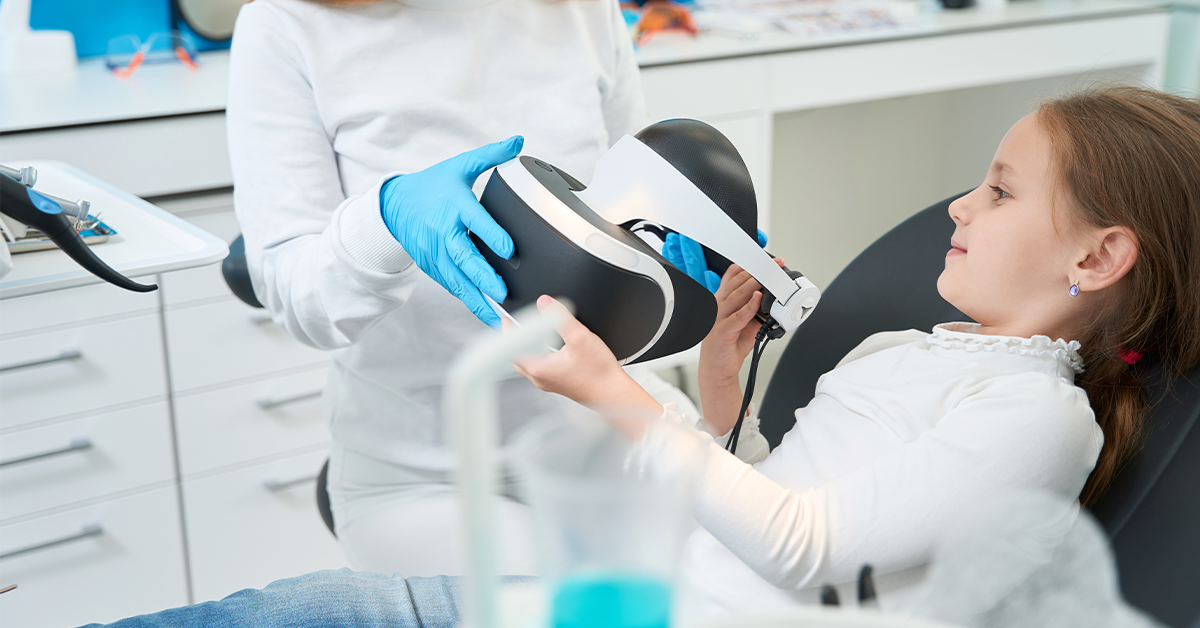Stepping into a dentist’s office can be nerve-wracking for many, but what if anxious patients could escape to a tropical beach or listen to a guided meditation session while sitting in the chair?
Thanks to virtual reality (VR) technology, this is becoming an option for patients who experience dental anxiety. Dentists across the country are using VR tools to not only create a calming distraction for patients during visits, but also to help prepare patients for the process of their appointment from a view they normally aren’t able to see. By blending innovation and technology, dentists are transforming the patient experience for the better.
Dentist visits are one of the most feared medical appointments in the U.S., with triggers ranging from past traumatic experiences to things such as the sound of a drill or the on-set of guilt over a lack of flossing (let’s be honest, we’ve all been here before). This can make a trip to the dentist such a high source of anxiety for people that they avoid it altogether, putting them at risk for oral health issues in the future.
Common solutions offered from the entire dental staff to help patients combat these anxieties are typically distraction methods such as music, stress balls or increasing communication and conversations around topics related and non-related to the appointment. As technology advances, so can these methods.
VR in the Dentist’s Chair
VR is a type of technology designed to transport users into immersive, computer-generated environments using a headset. Primarily through sight and sound, VR simulates a highly realistic setting like a beach, the mountains, a rollercoaster or a spa, and can make users feel like they are physically a part of these scenes. Along with environmental replication, VR offers other media experiences such as the ability to play games and even mimic medical scenes, like allowing users to pretend they are in an operating room. VR has become a hot item in high-stress industries like healthcare, due to its ability to provide specialized types of distractions.
The concept of using distraction as a method to reduce anxiety is not new and can be seen in long-time practices like meditation and music. Before the current digital age, it was up to individuals to imagine distractions. VR has been such a successful tool in distraction methods due to its combination of heightened physical and verbal stimulation, pushing users’ senses to make them feel like they entered an entirely different reality. Distractions at this level not only help with calming patients and allowing them to better manage internal emotional regulation, but can even be directly related to reduced pain perception.
Transforming Patient Care
One 2024 study investigated the effectiveness of VR in lowering pain associated with dental procedures and found that the VR environment significantly lowered pain perception during standard dental scaling. Another study found that VR can help patients with chronic pain management symptoms. Some dental offices have even found support in using VR to provide interactive 3D visualizations of dental anatomy and procedures to patients. This can look like giving patients a chance to virtually explore their own mouths as a procedure or treatment plan is explained to them, or even stem as complex as allowing dentists to simulate routines like dental implant placements or orthodontics adjustments. Nervous patients reported that this type of demonstration helped them visualize the process and prepare themselves for the real event.
It's always important to remember that this is a growing trend, and not everyone is suitable for VR technology. Proper understanding of the equipment paired with cost and accessibility are factors that go into considering implementing VR into any practice.
The bottom line: Reduced patient anxiety is beneficial for the entire dental practice. When patients are relaxed, staff can perform their jobs with greater ease, leading to more efficient days and appointment times. As technology like VR advances, its capabilities to help shape the world of medically-related anxieties is promising.

